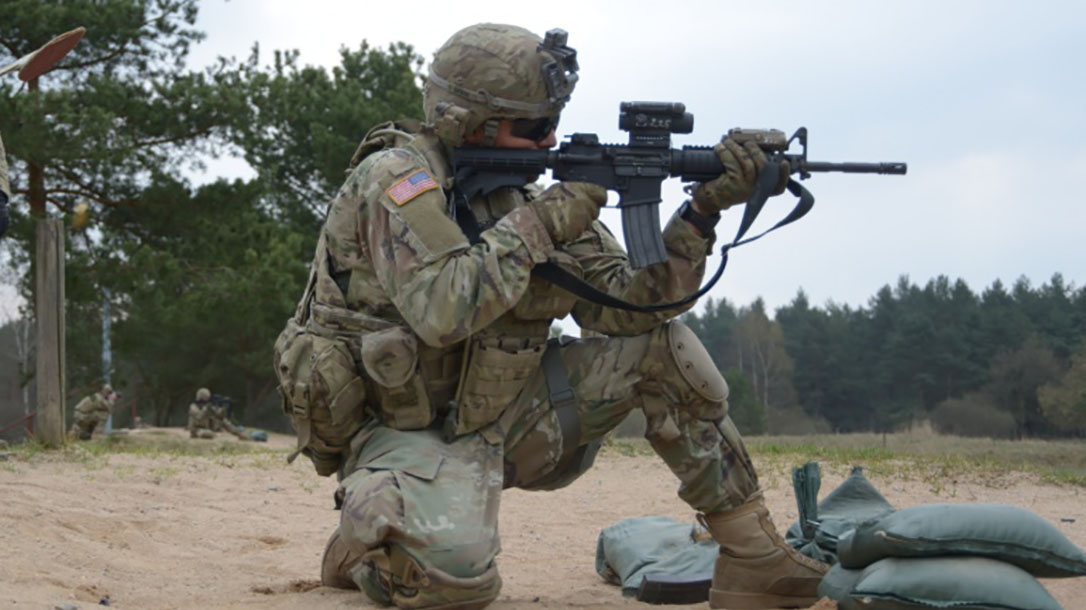A couple of months ago, a Soldier at Fort Knox, Ky., recorded a cell phone video of him experiencing an unintended discharge with his M4A1 carbine. As a result of that incident, U.S. Army Tank-automotive and Armaments Command (TACOM) has issued two Safety-of-Use Messages (18-004 & 18-005) calling for a new functions check and immediate action drill to deal with the issue.
“The operator pulled the trigger with the selector switch between the semi and auto detents (outside of detent). The weapon did not fire when the operator pulled the trigger and instead fired when the selector was moved further,” the Army safety messages read, according to Military.com.
Advertisement — Continue Reading Below
Military.com reports that the Soldier in question used an M4—capable of firing three-round bursts—that had been converted to a fully automatic M4A1 through the Army’s Product Improvement Program (PIP). Neither he nor anybody else was injured as a result of the mishap.
The M4A1 is the Army’s primary individual weapon.
The Army has caught the defect in about 10 percent of the weapons it inspected, Soldier Systems says.
Advertisement — Continue Reading Below
TACOM’s new safety messages are geared toward the M4 and M4A1, as well as the M16A2, M16A3 and M16A4 rifles. The messages state that the Army’s Armament Research, Development and Engineering Center (ARDEC), along with PEO Soldier’s Program Manager for Soldier Weapons, are still working on finding the cause of the malfunction.
Functions Check
Until a root cause is found, units must perform the following functions check on all M16 and M4 series rifles every 10 days or prior to live fire, whichever comes first. This, the messages state, will help Army officials determine which weapons, and how many, have the defect.
- Ensure weapon is clear by observing the chamber, the bolt face, and magazine well. The weapon should always be pointed in a safe direction.
- Charge the weapon, place selector lever on the safe position and pull trigger. The hammer should not drop.
- Move the selector lever to the semi position, then move the selector to a position between semi and auto, and squeeze the trigger. The hammer should drop when the trigger is squeezed. If the hammer does not drop when the trigger is squeezed, this is a failure. Record this information and continue to the next step.
- If the hammer does not drop, move the selector in either direction. If the hammer drops without squeezing the trigger, this is a failure. Record this information.
- Gather information recorded from failures at steps (3) and (4) and segregate the weapon for further investigation. Contact TACOM with the weapon serial number.
- If the weapon passes steps (3) and (4), the function check is complete.
Immediate Action Drill
In addition, TACOM has updated the standard SPORTS immediate action drill to C-SPORTS. If the weapon doesn’t fire when the trigger is pulled, Safety-of-Use Message 18-005 recommends the following:
Advertisement — Continue Reading Below
- Confirm that the selector is set to semi, auto or burst.
- Slap upward on the magazine to make sure it is properly seated.
- Pull the charging handle completely to the rear and hold.
- Observe for ejection of case or cartridge, and ensure the cartridge or case is ejected and the chamber is clear.
- Release the charging handle to feed a new round.
- Tap the forward assist to ensure the bolt is closed.
- Squeeze the trigger; the weapon should fire.

























